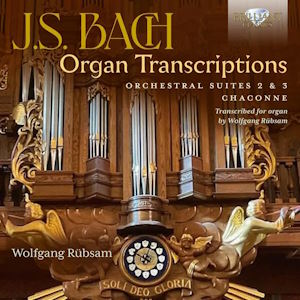
Johann Sebastian Bach (1685-1750)
Orchestral Suite No.3 in D BWV1068 (1731, transcr. Wolfgang Rübsam)
Chaconne from Partita No.2 in D minor BWV1004 (1720, transcr. Wolfgang Rübsam)
Orchestral Suite No.2 in B minor BWV1067 (1738-39, transcr. Wolfgang Rübsam)
Wolfgang Rübsam (organ)
rec. 2022, Church of St. Louis, King of France, St. Paul, USA
Brilliant Classics 96846 [71]
As I have often written in the past, I do enjoy a well-crafted transcription or arrangement of a familiar work whether this is to condense an orchestral score down to a keyboard or inflate a solo work to symphonic scale. When I saw that this new recital of arrangements made and performed by the reliable Wolfgang Rübsam included one of my desert island pieces – the Chaconne from the solo Violin Partita No.2 in D minor BWV1004 – I was keen to hear this disc.
Apart from his eminently sane and skilled playing and arranging, Rübsam is listed as the recording’s engineer and producer as well. The good news for organ aficionados is the Casavant organ at the Church of St. Louis, King of France, St. Paul, Minnesota USA sounds absolutely magnificent in the church’s very spacious and ample acoustic. Likewise half of the booklet – some 6 pages – is devoted to a detailed description of the organ, its installation and its registration. Sadly and surprisingly, I cannot say I enjoyed Rübsam’s interpretations much if at all. The programme itself is of real interest to fans of transcriptions. The two most famous Bach Orchestral Suites – Nos.2 and 3 – are offered complete and frame the majestic Chaconne. Essentially Rübsam’s style is unrepentantly ‘old-school’. Clearly in as big an acoustic as here there will need to be some allowance made for the reverberation time to minimise too much blurring of the contrapuntal detail. Christian von Blohn in his liner note praises Rübsam’s “clear and detailed playing” and that he “chooses the tempi prudently”. One person’s prudent is another’s slow and goodness me these are consistently turgid tempi that resolutely throw out of the window any ‘spirit of the dance’ the orchestral suites may contain.
As a guide (allowing for the fact that Rübsam plays all the ‘standard’ repeats and da capos); Trevor Pinnock in the Ouverture to Suite No.3 in D BWV1068 takes 6:05, here Rübsam is 9:47. The closing Gigue of the same suite; 2:57 compared to 4:32. Suite No.2 in B minor BWV1067 fares much the same – there the Ouverture is 6:10 to 10:05 and the closing skipping Badinerie 1:38 to 2:18. While Pinnock and his English Concert might represent the spirit of HIP practices many other recent versions are far closer in tempi and mood to Pinnock than the frankly stodgy Rübsam. This is a very specific artistic choice not dictated solely by the implications of the acoustic and certainly not by any technical concerns. Rübsam backs this up with registrations that are often very full – impressively so – that allows the Casavant organ to display itself in all its considerable glory. I must admit when I first played this disc I enjoyed the grandiose opening of the third suite but as the work and then the disc progressed I found the style and sound just too different from what I like to hear in Bach performance. I am glad that Rübsam avoided trying to create a kind of pastiche baroque organ version of these works. These are grand transcriptions in the Romantic manner – I just wish they danced!
In terms of basic pulse and tempo the Chaconne fares a lot better. Rübsam’s playing time of 16:01 is pretty middle-ground and certainly the music has a more flowing tempo throughout. The issues here are more to do with the arrangement and the registrations and the use of dynamics within phrases to point and shape the work’s architecture. Rübsam is emotionally pretty neutral with a sense of improvisatory freedom rather than structural rigour. So take the quite magical arrival at D major at pretty much the central point of the work. After the technical and harmonic complexities that precede this moment D major becomes a moment of serene balm; sunlight emerging from behind clouds. With Rübsam I have no sense of release or arrival. Neither does the return to D minor herald further struggles before the final resolving D. Another part of the problem is to do with the instrument and acoustic. On an organ in this kind of space a transcription such as this will introduce a bass line literally absent in the violin original. The nature of the organ registrations used and the acoustic draws the listener’s ear towards that line at the expense of the genius of the treble writing in the Bach original. Too often I realised that I was struggling to hear that upper line which I know so very well. The more familiar piano transcriptions of this work are able to manage this potential problem with the player able to balance the right and left hands in a way that organ pedals simply cannot be.
So a disc to be approached with a degree of caution. A magnificent organ very well recorded and played with skill and conviction. Just in a style that I could not relate to or enjoy at all.
Nick Barnard
Help us financially by purchasing from



















